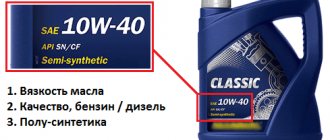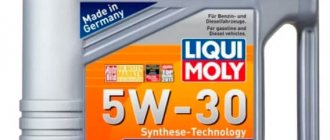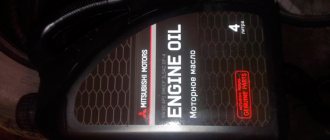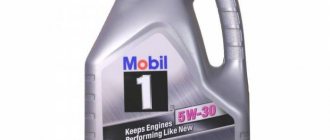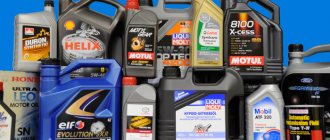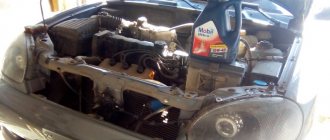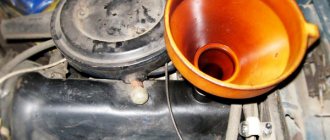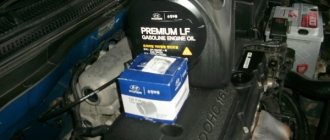Synthetic and semi-synthetic compounds
The semi-synthetic category of oils has the characteristics of mineral and synthetic products.
Owners of both new and used cars can use this product. Such compositions have a longer service life than mineral lubricants. The oil must be changed every 10,000 kilometers. Semi-synthetic products have increased performance and protective properties. However, they are not suitable for all vehicles. Old domestic cars, the engines of which use rubber products, may not withstand the effects of the chemical elements used in the production of modern motor oils.
Synthetic lubricants are more suitable for new imported and domestic cars or cars with low mileage. Such products have a completely artificial base, to which many different components have been added that increase engine life. In new car models, all oil seals, cuffs and gaskets are made of materials that can easily withstand the effects of synthetic compounds. But with old cars the situation is ambiguous. It is better not to experiment, since there are known cases where, after using this type of lubricant in an old VAZ car, the engine crankshaft oil seals failed.
Owners of used domestic cars should pay attention to mineral oils or semi-synthetics that are not too aggressive. Synthetic compounds should not be used.
The best oils
The list of the best oils intended for engines with high mileage includes foreign and domestic products. If previously it was believed that only imported brands could offer high-quality lubricant options, today Lukoil and other Russian manufacturers have significantly improved the quality of their offerings, so experts often recommend such lubricant for engines with high mileage.
The list of the best includes Shell Helix HX7, ENEOS from JX Nippon, Mobil1 oil, Lukoil Lux 10W40. Such oils are intended for both naturally aspirated and turbocharged engines; it improves engine performance and prevents increased wear. By choosing the right lubricant, you can completely protect the engine from corrosion and wear, extending the life of the old engine.
Mobil1 and Shell Helix
Lubricant from Mobil1, which combines excellent quality and is designed for new turbocharged and highly accelerated units, is very popular among car owners. This oil is made on the basis of synthetic components, has a minimum level of ash content, and is suitable for Audi, Mercedes and BMW engines. On sale you can find varieties of such lubricant intended for diesel and gasoline engines. By choosing this oil, you can significantly extend the life of the engine, which will be protected from wear and cleaned with special additives from any contaminants.
For engines with high mileage, Shell Helix HX7 oil is recommended. Thanks to its viscosity of 10W40, this lubricant is ideal for worn-out engines. Its use reduces friction between moving elements, creating a reliable oil film that protects the internal elements of the engine. The motor gains increased resistance to oxidation and shear loads. This lubricant will be an excellent choice for inexpensive foreign cars that require high-quality synthetics. The cost of Shell Helix HX7 is about 1,200 rubles for 4 liters of oil.
ENEOS by JX Nippon
For used Japanese and Korean cars with high mileage, it is recommended to use ENEOS oil from JX Nippon. The use of such a lubricant ensures a long service life of the motor, preventing its premature wear. This is a high-tech product that significantly improves the performance of engines, returning lost horsepower, washing away all existing contaminants.
This oil is capable of maintaining all its performance characteristics for more than 10,000 kilometers; it simplifies engine starting at low temperatures. Another undoubted advantage of ENEOS synthetic oil is its affordable cost, which is about 1100-1200 rubles for 4 liters. You can choose varieties of this lubricant that differ in their viscosity, the presence of additional additives, and also intended for engines of various types.
Lukoil Lux 10W40
Lukoil Lux 10W40 oil was developed especially for owners of domestic VAZ cars, which costs 800 rubles per 4 liters. Such expenses will be affordable for every car enthusiast. This lubricant is intended for non-boosted engines with high mileage and can withstand 7-8 thousand kilometers of a vehicle without deteriorating its characteristics.
The use of various additives allows for excellent anti-wear properties; this oil does not contain aluminum, and therefore does not adversely affect the general condition of the engine. Its only drawback is the difficulty of starting the engine at temperatures of -30 degrees and below. It is not recommended to use it in northern regions during the winter season.
conclusions
By choosing the right oil for a worn-out engine, you can restore a second youth to your car. Such oils prevent increased wear, eliminate contaminants present in the engine, protect moving elements, relieving car owners from the need to perform major engine repairs. Today you can find various types of such oils on sale, which are created specifically for gasoline and diesel engines with high mileage.
Source
High mileage engine
As a rule, when a car crosses the 200 thousand km mark, experts recommend using semi-synthetics instead of synthetics. First of all, this is due to the loss of engine performance characteristics. Therefore, in order to know which oil viscosity to use, it is necessary to take into account the technical condition of the engine.
More on the topic: Shell Helix Ultra motor oil with viscosity 5w30 and 5w40, main differences
Increasing the mileage of an internal combustion engine implies certain changes and requirements for the viscosity characteristics of the lubricant. Experienced mechanics recommend pouring oil with a high index into the engine for optimal fluidity and lubrication of worn parts. The sooner the car owner replaces the composition with an analogue with the appropriate viscosity characteristics, the greater the likelihood of maintaining the functional state of the internal combustion engine.
It is also worth noting that it is not recommended to pour oils with a high viscosity index, such as 20w50, 10w50, into worn engines. Due to its liquid state, the formed microfilm will regularly drain from the surface of the rubbing mechanisms, which can lead to wear and overheating of parts.
Therefore, in order to choose the most optimal oil viscosity for both winter and summer, you need to choose 5w40, 10w40. In severe frosts, you can use 0w20, and then make a smooth transition to 5w30.
We recommend: 10 most popular small cars in Russia and their problems
Marking on motor oil packaging
It is difficult to determine which mark corresponds to the best oil for a high mileage engine. To do this, you can study the manuals, which describe the nuances of operating a particular engine. You need to look for lubricant containers with appropriate markings for the situation.
The vast majority of cans and canisters indicate two parameters - thickening index and viscosity index. As an example, consider the SAE 10W-30 marking. The first number determines the thickening of the oil. The lower the indicator, the lower the ambient temperature is allowed for operation. The second number determines the degree of viscosity; the composition is demonstrated at a temperature of 100 degrees Celsius.
Another standard that is widespread throughout the world is API. Its index consists of two letters of the Latin alphabet, the first of which is invariably S. The higher the serial number of the second letter, the better the quality of the oil. Thus, for engines with high mileage, the SF standard is recommended.
Signs of a Worn Engine
First you need to deal with the signs of a worn-out engine, when regular oil is no longer effective. There are 5 of them in total. Mainly, these are changes in the behavior of the engine on the road and most of them are visually invisible.
- Check Engine Button. Over time, when starting the engine from the ignition switch, its appearance becomes noticeably more frequent. This indicates a malfunction of the automotive heart. Sensors report the beginning of a leak in the cylinders, an insufficiently thoroughly developed mixture of fuel and air.
- Unstable engine operation. In normal mode, the motor operates properly without unnecessary knocking. As the mechanisms wear out, friction appears between the mechanisms and they begin to knock. The result is obvious - after some time, a piece of property will be added: the car will become “real estate”.
- Sometimes the cause is spark plugs. Abrasion of the electrodes can cause insufficient ignition effect and, as a result, fuel detonation inside the cylinders. Hence the feeling of war in the engine.
- Unpleasant odors and discoloration of exhaust smoke also indicate engine malfunctions. Clogged exhaust ducts force them to visit the vehicle interior. The impurities they contain are unsafe for human lungs. Significant accumulation may result in loss of vehicle control and death.
Micro-Ceramic Oil
The criticality of the path traveled
Many people are interested in what mileage is the maximum for a given vehicle. After all, the term “high mileage” does not give a complete idea that it is time to repair the internal combustion engine due to changes in its parts and components (wear, destruction).
To determine that many kilometers have been traveled, there are no clear indicators in numbers. It is believed that a domestic engine that has worked for 100 thousand km has a high mileage. At the same time, the characteristics of some Japanese power units do not change after ten thousand kilometers. The average distance without the need for major repairs and the risk of breakdown from wear for imported engines is 150 - 200 thousand km.
If a foreign engine begins to fail before the established mileage standards, it means it is being operated in violation of:
- use of low-quality fuel;
- the brand of engine oil does not correspond to the recommended one;
- violation of the recommended regime between service replacements of lubricant.
Compliance with established rules when carrying out the procedure for changing engine oil is of great importance. It is recommended to trust these activities to experienced employees in a car service center.
The best ester motor oils
During operation, esters are able to clean even the dirtiest engine, which has not seen normal oil since leaving the assembly line. But they buy such expensive fuels and lubricants mainly for sports and racing cars.
Motul 300V Power – “long-lasting” oil for motorsport
4.7
★★★★★
editorial assessment
97%! buyers recommend this product
Motul Power is produced using the unique Ester Core technology based on plant esters. But its main feature is the base, which includes from 25 to 50% hydrotreated oils.
Thanks to this, Motul does not have to be drained after each race, as is the case with other esters. The period of its replacement is close to traditional synthetic compounds.
The hydrocracking product does not coke, does not burn, and does not curl. In addition, it received an improved ZDDP additive package, which is ahead of modern sports standards.
It also includes a molybdenum friction modifier - this substance ensures maximum sliding of the contacting parts. As a result of all the improvements, the oil was awarded API (SN|CF) and ACEA A3, B4 approvals.
Advantages:
- absence of fakes on the market;
- fast pumpability at low temperatures;
- all-season;
- stability of pressure, viscosity and oil film layer;
- minimal volatility;
- maximizes engine potential.
Flaws:
- high price;
- extremely narrow scope of application.
The product was developed specifically for motorsports, but has recently been increasingly used in cars such as Subaru and BMW and is generally suitable for all types of internal combustion engines.
Mannol Racing Ester - inexpensive oil for high-performance engines
4.9
★★★★★
editorial assessment
72%!
Synthetic oil with ester components is produced using suspension technology. It was developed to service highly accelerated four-stroke engines (both gasoline and diesel engines).
We recommend: Engine oils 5W40 and 5W-30 - the main difference between the products
Racing Ester can withstand extreme loads and temperature changes. Its components form a thick technical film on engine parts, which protects them from wear even during startup at low temperatures.
Additives have increased resistance to oxidation and extend the service life of the oil base. As a result, fuels and lubricants do not burn out and do not coke for a long time.
A special feature of this product is its detergent additive package. Thanks to them, the engine remains clean even after long and intensive use. The oil itself has API approvals - SN|SM|CF and ACEA A3|B3|B4.
Advantages:
- low price;
- good performance characteristics;
- does not require the use of flushing oil;
- long replacement period;
- detergent components as part of an additive package.
Flaws:
- there are a lot of fakes on the market.
Mannol, as always, released an excellent oil with a sporty twist and left all its competitors behind by setting the minimum price for its product.
Oil for 100,000 km. mileage
Oil change in cars with mileage over 100,000 km.
What to choose from a huge assortment for the engine, so that it cleans and soaps, and protects against wear. Just not semi-synthetics with low viscosity like 10W40.
This review is about a product that is specially invented for cars with high mileage. A huge number of cars, about 20 million in Russia, whose engines have driven many kilometers and these cars are already over 12 years old.
Problems often arise with waste and oil leaving the system. Where and why is a sometimes incomprehensible question. It seems like the replacement was done on time, the engine is like a clock, rubber bands, and gaskets are not leaking normally. What's the matter? But the main reason lies in the choice and filling of engine oil. Over time, parts are subject to wear and destruction.
In our country, due to temperature changes, large traffic jams and often loads on the car body, the engine wears out much faster than in other European countries. Accordingly, the usual oil prescribed in the book may no longer be suitable.
For the protection and durability of motors, special products are created for 100,000 km. It contains a different additive package that is aimed at protecting against wear. Additives that create a more durable layer of lubricant at the molecular level and restore the elasticity of gaskets. Also, stabilizers added to the product maintain the desired viscosity and do not settle from the parts while parked.
That is, it’s the same as adding a viscosity stabilizer or “stop leak” to stop the loss, and therefore prevent oil starvation.
The rings also lie there, and a strong zhor begins. This needs to be stopped.
Often all the dirt and deposits are at the bottom of the cylinder block. They clog the oil receiver. Therefore, to check, remove the oil pan. It is carbon deposits that clog the oil receiver and lead to a lack of lubrication, leading to the failure of the unit itself.
You can remove the top valve cover, and you will see the same deposits that need to be removed, of course.
If you do not want to use modern washes, cleaners and other means, then fill in special ones. product 5w40 FS 100,000 km. and 5W50 FS.
As the test shows after changing to FS 5w40 and a mileage of 10,000 km. On the highway at an average speed of 80 km/h. The engine has become cleaner and runs quieter. The parts were covered with the correct film of golden color, and not dark as before.
There is no need for rinsing when filling. The oil removes sludge and deposits in just one change. As for the bottom, it worked there too and removed the unwanted and black deposits, clearing the oil pan.
Mineral lubricants
Although these oils are the cheapest, this does not mean that they are bad or of poor quality. Such lubricants are made from natural petroleum products and are chemically neutral. They do not have a negative impact on parts made of rubber in the car engine.
Previously, it was believed that the quality of mineral products leaves much to be desired. However, with the advent of imported formulations, the opinion changed. Most military and special equipment, as well as heavy-duty vehicles, use mineral products. In engines of cars with high mileage, especially domestic ones, it is also worth using similar compositions. This is due to the fact that mineral products are cheaper than other types, and oil consumption in worn-out engines always exceeds the norm.
The disadvantages of this category of oils include the need to replace them more frequently, approximately every 5000-8000 km. In addition, such compositions are quite sensitive to external temperature changes, despite the fact that the labels of many of them are decorated with the inscription “all-season”.
Is it suitable for older GTL based Shell Helix Ultra engines?
Different oil bases often confuse car enthusiasts. Not everyone knows the difference between gas and oil. Shell Helix Ultra oil based on GTL, which appeared on the shelves of auto stores, represents precisely the first category. It is labeled as synthetic and made by converting gas to liquid (GTL, gas-to-liquid). Suitable for any engines, including used ones. The main advantage is the price, since it is made on the basis of polyalphaolefins and more complex polyesters, which allows the price tag to remain at the level of mineral hydrocracking oils.
The difference in the basis also affects the quality. The lubricating properties of GTL oil are better than those of polyesters and PAO. There is also no hygroscopicity: the substance does not absorb water, which worsens all the properties of any lubricant.
Of course, engines from different manufacturers have different properties. Moreover, the individual driving style of their owners leaves its mark on the insides of the car in general and the engine in particular. Changing the type of lubricant, of course, is necessary after a long mileage, but this must be done knowing the operating conditions of the car and under the supervision of professionals.
Recommendations from experts on choosing oil viscosity
According to auto mechanics and vehicle manufacturers, it is necessary to use:
- All-season 5w40, if the engine mileage is more than 100 thousand km. In summer, 10w30 is recommended for the engine;
- All-season 5w50, if the engine mileage is more than 250 thousand km. For winter - 5w40 or 10w
More on the topic: Mobil 1 oil viscosity
But taking into account these recommendations, we note the fact that the power unit may lose functionality and be in a worn-out state after reaching 50 thousand km. Therefore, such indicators should only be considered in the presence of normal engine operating characteristics.
Recommendations for selection
Now to the question of which oil would be best to pour into an old, worn-out engine. The mark of 100-150 thousand kilometers has been passed. Therefore, it's time to make changes to the standard oil program for your car.
The first thing to remember is that, regardless of the mileage or condition of the engine, you cannot switch to a lubricant that does not meet the tolerances, specifications and class prescribed by the manufacturer.
It is important to understand that on older cars there were certain tolerances. But over time they have changed. The oils prescribed in the manual are no longer for sale. Instead, higher-class trains appeared.
Therefore, the main choice is made not based on tolerances, but on the possibility of using the oil in a particular engine. Typically, the lubricant manufacturer prescribes the relevant information in the instructions and specifications.
At the same time, remember that a number of modern new generation oils cannot be used for filling into engines of previous generations. This mainly concerns oils with reduced high-temperature shear viscosity. Labeled as HTHS.
In modern internal combustion engines, energy-saving lubricants are necessary to reduce fuel consumption. But the design of the motor was initially designed for the fact that a composition with a low-viscosity characteristic would be poured into it. Pouring this oil into an engine that is not adapted to such a liquid will greatly accelerate wear, leaks will form, and this will lead to engine failure.
Also to the question about the type of oil. For each engine, recommendations are prescribed for the use of synthetic, mineral and semi-synthetic oil. If the plant does not allow the filling of mineral water, then it is not worth doing. For some reason, it is believed that the best motor oils for engines with fairly high mileage are exclusively mineral ones.
But this is a myth that is associated with past developments and old engines. This was once relevant. Now you can only harm the internal combustion engine if you fill in cheap mineral fluid instead of the required synthetics.
Selection of oil for an older engine
The problem with choosing a lubricant for an aged engine is aggravated by the insistent requirement to follow the manufacturer's recommendations. But there are two nuances here. The first is the obligation to follow recommendations during the warranty period. Secondly, the warranty service ends at 100-150 thousand kilometers. Further, all responsibility for maintaining the performance of the motor falls on the owner.
We recommend: Contract engine versus overhaul
Many owners continue to fill in the usual oil after the odometer passes the sixth digit. This can be done with a certain reservation. If there is any suspicion, a thorough diagnosis should be carried out, especially if olive consumption has increased sharply.
Avoid buying oils developed in the shaggy years; it is advisable to give preference to recent inventions. Compatibility with a specific motor in color is required, as well as in accordance with the season. The main condition is that the properties of the selected oil are an order of magnitude higher than the minimum acceptable standards.
Kroon Oil Seal Tech
When moving beyond a hundred thousand kilometers, you need to increase the viscosity of the oil. Let's look at an example. If 5w30 is poured into a new car, then after the first overhaul it is worth using 5w40. And from the 200 thousand kilometer mark, completely switch to 10w40.
Extending service life with special oils
When the car odometer gets closer to dangerous levels, going far beyond 100-200 thousand kilometers, drivers are interested in the question of possible extension of the life of the internal combustion engine by switching to special lubricants. This is a completely natural desire, since major repairs and serious financial costs are unlikely to please anyone.
It is important to understand that there are simply no drugs against old age and engine wear. They don't exist. Any motor oil manufacturer will tell you this. When it comes to supposedly special liquids, they mean compositions with certain additives or an increased amount of them.
Experts and experienced motorists give their recommendations on which oil will be best for your car with a mileage exceeding 100-200 thousand kilometers. They advise switching to compounds with higher viscosity than those that are being poured now. Here you definitely need to look at the instruction manual. When the manufacturer's recommendations indicate the use of oil with a viscosity of 5W40, in case of severe wear of the internal combustion engine, switching to a liquid with a viscosity of 5W50 is allowed.
But even such decisions and changes provide only a temporary effect aimed at normalizing engine operation. Lubrication will not affect its condition in any way. Oil cannot protect against wear. Such problems are solved exclusively by repairing or replacing components that have truly lost their performance characteristics. If you expect that switching to a special oil will instantly return the engine to its previous dynamics, reduce fuel consumption and improve condition, it is in vain. Switching to a more viscous oil simply does not allow the engine to wear out at the same rate as before.
It is difficult to give an unambiguous and universal answer to the question of which oil would be best to pour into a particular old, worn-out engine. Each motor has its own characteristics and properties, which the fluid used must correspond to. But switching to a composition with increased viscosity most often gives a positive result. Although it is also impossible to exclude the occurrence of some problems.
Changing the working fluid to a more viscous one, that is, thick, while maintaining all the specifications for your engine, will better protect the rubbing elements without forming too thick a film on their surface. Preference should be given not to those lubricants that create the thickest films, but to those that are able to form the most durable coating on parts. This is a huge and fundamental difference. A thick film can be achieved by switching to regular mineral water. But high-strength properties are characteristic of modern synthetic compounds. Among the current proposals, it is not difficult to find mixtures that ensure indelibility of the film due to special additives. This effect is achieved through the use of esters.
But pouring more viscous working fluids is carried out only with increased gaps in the friction pairs. If you take a composition whose properties do not match the engine, active oil consumption will begin. Viscosity coefficients change strictly in proportion to the wear of the internal combustion engine. That is why manufacturers never give exact numbers, but offer a certain range within which different viscosity coefficients can be selected, depending on the specific situation. But going beyond this range is strictly not recommended. Each power unit was created and designed to work with specific operating lubricants. If you fill in a lubricant that is not suitable for the engine, you will only aggravate the situation, provoke serious problems and accelerated failure of the internal combustion engine.
There is a category of experts who do not share the opinion about the benefits and advisability of switching to more viscous lubricants. They believe that such decisions can only cause harm and cause problems in the operation of the power plant. They also have arguments. The pump responsible for pumping lubricant is not adapted to work with high-viscosity oil, which causes accelerated wear of this element.
Another argument is the likelihood of oil starvation in some areas of the engine, which leads to failures and breakdowns.
In order not to find yourself between a rock and a hard place, asking the opinions of various specialists and experienced motorists, it is worth looking at the instruction manual. It clearly states which oils and with what range of viscosity coefficients are allowed to be used. It is within this framework that we should act.
The best engine flushing oils
The modern market in this niche offers traditional mineral-based oils, as well as long-term and five-minute washes.
The latter are ineffective and do more harm than help. Therefore, the search range is narrowed to mineral water and high-quality fills.
Liqui Moly Oil-Schlamm-Spulung – flushing additive
4.9
★★★★★
editorial assessment
90%! buyers recommend this product
The long-lasting washing liquid contains heat-stable dispersants and slightly soluble detergents. They effectively remove oil layers, sludge and dark sediment from the crankcase and circuit.
The product is universal and suitable for cleaning engines of any design. And yet it is not a lubricant in the full sense.
Oil-Schlamm is added to the engine oil shortly before its scheduled change. As a result of such flushing, fuel consumption is reduced, the knocking of hydraulic compensators and noise in the chain drive are eliminated. The power of a cleaned motor increases, and starting it no longer causes problems.
Advantages:
- compact packaging;
- soft, layer-by-layer cleaning;
- safe for sealants;
- forms a protective layer that prevents wear of the mechanism;
- maximum removal of contaminants and used oil;
- easily removed from the system.
Flaws:
- the price is above average.
Oil-Schlamm-Spulung is recommended for high-mileage internal combustion engines with high wear. It is better to fill it in the last 200 km before changing the oil.
What's the result?
Taking into account the above, several conclusions can be drawn. First, if the engine has high mileage but is running fine, then it is better to slightly increase the high-temperature viscosity of the oil without changing its base. It turns out that it is enough to switch, for example, from 5W30 to 5W40 lubricant (if the use of such a product is allowed by the engine manufacturer).
You can also use oils that belong to a higher class, but are suitable for a specific power unit. It should be remembered that in engines produced before 2000 it is almost always prohibited to use oils with a reduced high-temperature shear viscosity.
A common situation is when the engine already has problems during operation:
In this case, increasing the viscosity of the lubricant eliminates some nuances and reduces noise. For the summer, you can try pouring thick mineral water (for example, 15W40) from the list of lubricant types recommended by the car manufacturer for a specific engine. In this case, before winter you will need to return to a less viscous semi-synthetic or synthetic product (for example, 5W-40) to eliminate cold start problems.
During the process of seasonal transitions, it is important to consider that not all oils can be mixed with each other. In some cases, flushing the engine before changing the oil helps, in others it is better to avoid such a step. For worn out and contaminated internal combustion engines, the use of active flushing can lead to final failure of the unit.
As a result, the lubricant becomes less viscous, and the breakdown products of the additive package further contaminate the oil system. As for highly viscous mineral water, in this case it is necessary to further reduce the scheduled replacement intervals (up to 4 thousand km).
Engine oil viscosity, what is the difference between oils with a viscosity index of 5w40 and 5w30. Which lubricant is best to pour into the engine in winter and summer, tips and recommendations.
What is better to use: synthetic or semi-synthetic oil. When is it optimal to fill the engine with synthetics and in what cases is it a semi-synthetic product?
